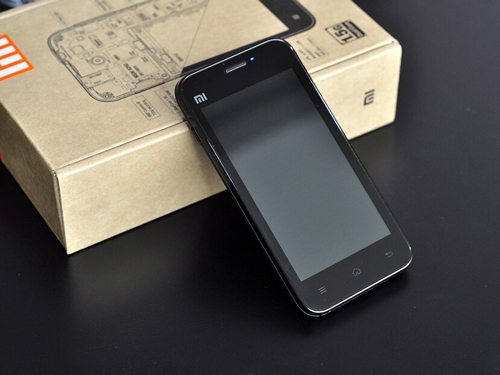 On the red-hot, radiant screen background, listening to keywords like “miracleâ€, “first lineâ€, “dual coreâ€, “as long as 1999â€, “real moneyâ€, etc., this seems to be a marketing scene for television shopping. However, this is the December 20 press conference where Xiao Jun and Unicom announced the launch of contract handsets.
On the red-hot, radiant screen background, listening to keywords like “miracleâ€, “first lineâ€, “dual coreâ€, “as long as 1999â€, “real moneyâ€, etc., this seems to be a marketing scene for television shopping. However, this is the December 20 press conference where Xiao Jun and Unicom announced the launch of contract handsets. Different from the previous "Jobs" appearance, Lei Jun used a more high-profile debut, because the millet phone series of data let it emboldened: August 16 release, Xiaomi mobile phone at the time of Baidu heat reached iPhone 4S Two-thirds; on September 5th, reservations were made, and 320,000 reservations were made within 34 hours, and 215,000 units were finally shipped. After opening sales on December 18, 100,000 machines were swept away within three hours...
Yu Yingtao, former general manager of China Unicom's sales department, mentioned that there are two reasons to look at Xiaomi: “First of all, Xiaomi’s MIUI system has 1.7 million fans actively commenting on MIUI. They are updated once every five weeks. This is not what ordinary companies can do." Second is the high price of millet.
These may be regarded as a factor in the temporary success of the Xiaomi mobile phone. The interpretation of Lei Jun’s “play†is first based on Android, but establishing a small ecosystem that owns the right to speak, from software to hardware to application resources; second, “shanzhai†apple marketing, such as advance online Booked "hungry" marketing. These are different from the traditional operating ideas of other domestic smart phones.
The origin of this idea has been traced. The biggest impact of the rise of mobile Internet and smart terminals on the traditional mobile phone industry is that game rules and voice rights have completely changed. No company can independently provide consumers with a complete solution, including Apple, and the industry is beginning to enter the era of semi-finished products. "Either the software or hardware vendors or developers, they provide only "semi-finished products," and then "combine" together to form a competition between the ecosystem and the ecosystem.
Lei Jun’s train of thought is also aimed at this: “Own development of an independent operating system is achievable. The real problem lies in how to build an ecosystem.†Therefore, Xiaomi’s first product was launched in MIUI in August 2010. Test version. In fact, MIUI is a deeply customized version for the Android operating system, and also cuts into the Android ecosystem.
As a result, MIUI accumulated the first wave of popularity for Xiaomi, and the second wave was released on December 10, 2010 by Michao (supporting a free mobile instant messaging tool across cell phone operating systems platforms across mobile operators). The rice chat community that was established at the end of 2010 made these popular places “placedâ€. However, Lei Jun also faced two problems: First, how to realize the popularity, that is, the profit model; Second, the counterattack of giants, such as Tencent rely on huge user resources to launch WeChat. He needs a terminal that is more sticky to users and can be sold directly.
In addition to these problems, how to achieve sustainable capital investment has also become a challenge to Xiaomi. At the press conference that day, Lei Jun also deliberately announced the financing situation: Qiming Venture Capital, Shunwei Fund, IDG Investment, Morningside Capital, Qualcomm Investment and Temasek introduced the front line and announced the latest financing of US$90 million. In addition to continuing deep cooperation, Foxconn will increase Foxconn as a supplier in 2012.
The dismantling of Lei Jun’s style of play reveals that every step has its own predecessors’ shadow. Lei Jun only effectively combined them and made a “unique†millet in China. Drawing on business models and marketing gimmicks is the first step to success. However, there are many hidden dangers in the growth of Xiaomi. For example, the outside world has always questioned Xiaomi's ability to control the supply chain and lack of operator support. Although the contract machine agreement reached with China Unicom allows it to enter the operator's channel, but in the future, whether Xiaomi's mobile phone can make up the manufacturing short-board while the sales volume is increasing still remains to be tested.
LED Highbays Is one of the most important lamps, it can use electricity and save money.Large commercial Spaces can generate a return on investment in products with a useful life of 5 years in 18 months. LED Highbays can eliminate the expensive maintenance cost of LED 50,000 hours of life, and the operating cost is more than 50% lower than traditional metal halides.LEDER is Suitable for all occasions.1-10v dimming means you can choose between automatic standby technology or the latest daylight capture technology to increase your power savings.LEDER has intelligent sensors ensure that the lights are not completely on when not needed.More importantly,LEDER has waterproof IP67 grade,which can be used with rain.
• Highly efficient
• 50,000 hour expected lifetime
• 1–10V dimming to support daylight harvesting and occupancy sensors
• Industrial strength ratings against impact, dust and moisture
LED High Bay Light
LED High Bay,High Bay Lights,LED Warehouse Lighting,High Bay LED Shop Lights
JIANGMEN LEDER LIGHTING CO., LTD , https://www.lederlight.com